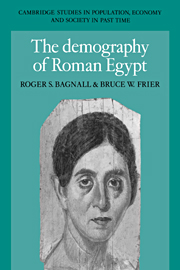Book contents
- Frontmatter
- Contents
- List of figures
- List of tables
- Foreword
- Preface
- A note on references and abbreviations
- 1 The census returns
- 2 The census returns as demographic evidence
- 3 Households
- 4 Female life expectancy
- 5 Male life expectancy and the sex ratio
- 6 Marriage
- 7 Fertility
- 8 Migration
- 9 Conclusion
- Catalogue of census declarations
- Catalogue of census declarations Supplement
- Appendixes
- Bibliography
- Index
- Cambridge Studies in Population, Economy and Society in Past Time
4 - Female life expectancy
Published online by Cambridge University Press: 06 January 2010
- Frontmatter
- Contents
- List of figures
- List of tables
- Foreword
- Preface
- A note on references and abbreviations
- 1 The census returns
- 2 The census returns as demographic evidence
- 3 Households
- 4 Female life expectancy
- 5 Male life expectancy and the sex ratio
- 6 Marriage
- 7 Fertility
- 8 Migration
- 9 Conclusion
- Catalogue of census declarations
- Catalogue of census declarations Supplement
- Appendixes
- Bibliography
- Index
- Cambridge Studies in Population, Economy and Society in Past Time
Summary
The Egyptian census returns preserve reported ages for 337 women. These ages are collected in Table A, which lists females resident in villages and nome metropoleis, and the total for each age. Table 4.1, derived from Table A, groups the same females into five-year age groups.
Even casual inspection of Table 4.1 indicates that Egyptian females were subject to heavy mortality. For ages 0 to 24, there are an average of more than 35 females in each five-year age group. By contrast, for ages 55 to 79, this average drops to only five females in each age group. Although the figures in Table 4.1 display many statistical inconsistencies, it appears that only a small proportion of Egyptian females—perhaps as little as a fifth—survived from their teens to their sixties.
To what level of mortality do the figures in Table 4.1 correspond? This chapter attempts to determine this at least approximately. But we begin with a more theoretical introduction to our working methods.
Life tables and stable populations
Life tables were introduced above in Section 1 of Chapter 2, where we discussed the Coale-Demeny Model West, Level 2, for females. Table 4.2 (p. 77) reintroduces that model, but with three additional columns of interconnected figures. As will be recalled, q(x) is the probability that females of exact age x (that is, on their birthday x) will die before their next indicated birthday, usually within five years; l(x) gives the number of survivors to exact age x from a theoretical “cohort” of 100,000 newborn females; and e(x) represents the average life expectancy of females aged exactly x.
- Type
- Chapter
- Information
- The Demography of Roman Egypt , pp. 75 - 90Publisher: Cambridge University PressPrint publication year: 1994
- 3
- Cited by



